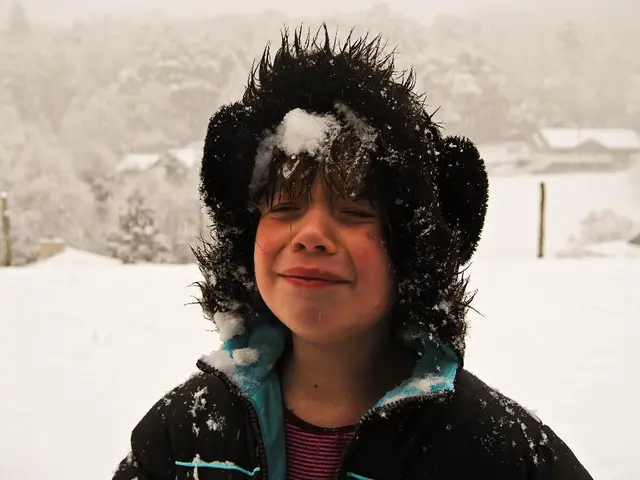Visual Depiction of Despair: Investigating Graphic Symbols that Signify Depression and Melancholy
Symbols Unveiled: Articulating the Unspoken
The power of symbols to express emotions, particularly sadness and depression, has been a cornerstone of human communication for centuries. This exploration delves into the multitude of ways cultures and historical eras have employed visual symbols, animals, natural elements, and colors to convey feelings of melancholy and despair.
Catching the Rain:Colors have always played a significant role in evoking specific emotions. In Western art, somber and muted tones - like grays, blues, browns, and dark greens - are commonly utilized to convey melancholy and introspection. Black, being universally associated with mourning, grief, and loss, is a dominant visual symbol of sadness and death. Shades of blue, often depicting sadness in Western contexts, are contrasted with some East Asian cultures, where the emotional associations with the color may be less dominant.
Feathered Foreshadowers:Birds like owls, ravens, and crows often serve as omens of death or sorrow across various mythologies. For instance, the raven is a symbol of mourning in some Native American and Celtic traditions. In English folklore, a persistent black dog is associated with depression and melancholy. The crow is frequently seen as a symbol of loss or desolation in different cultural stories.
Withering Blooms and Arid Terrains:Wilting or dead flowers are commonly used in art traditions to symbolize the transience of life and the inevitability of death, invoking feelings of sadness. Desolate landscapes, such as winter scenes, barren fields, or stormy seas, are also employed to convey emotional desolation or depression. Skeletons and skulls, across cultures, represent mortality and the fragility of human life, often evoking sorrow or existential reflection.
Artistic Evolution:From Renaissance and Romantic artists like Albrecht Dürer and Caspar David Friedrich, who depicted melancholy through contemplative figures, isolated landscapes, and symbolic objects, to Edvard Munch’s The Scream, which uses distorted forms and a bleak color palette to express existential anxiety and depression, visual art has long been a means of exploring and articulating the complexities of emotional experiences.
Symbolism in Other Cultures:Eastern art traditions, for example, use falling cherry blossoms to symbolize the fleeting nature of life, often evoking a sense of sadness. In Chinese and Japanese art, bamboo bending under snow represents resilience in adversity, but also conveys hardship and struggle. Ancient Egyptian artists used recycled scarab beetles, while generally symbols of rebirth, to represent cycles of life and death, invoking feelings of profound sadness and introspection.
Myth, Legends, and modern lore:Myths and symbols have evolved to fit the anxieties of their time, helping people express and process new forms of sadness and despair. For example, vampires in Western literature and film have symbolized societal fears and anxieties, representing collective sadness or depression during different historical periods.
Artistic Representations:Muted colors, black, owl, raven, crow, wilting flowers, desolate landscapes, skeletons, vampires, and mythological figures have all played significant roles in visually communicating complex emotions like sadness and depression. These symbols are used in various art forms, from painting to poetry, and evolve according to the context and historical period.
References
Note:While understanding and recognizing depression symptoms is crucial, symbols alone are not sufficient for diagnosis or treatment. They can, however, serve as valuable tools for initiating conversations about mental health and encouraging those who may be struggling to seek professional help.
Explore Further:
- Explore the evolving representations of depression in popular media over the years.
- Investigate symbolic expressions of depression and melancholy in various cultures, from ancient Egypt to contemporary Japan.
- Examine the development of artistic movements that aimed to express the emotional turmoil of their time, such as Expressionism, Surrealism, and Abstract Expressionism.
- Research the use of flowers, animals, and natural elements in literature, music, and film to symbolize feelings of sadness and depression.
- Analyze the portrayals of depression in different subcultures, such as emo or goth, examining the significance of their chosen symbols and visual representations.
References
- Cirlot, J.E. (2002). A Dictionary of Symbols. Dover Publications.
- Kövecses, Z. (2000). Metaphor and Emotion: Language, Culture, and Body in Human Feeling. Cambridge University Press.
- Lupton, D. (1998). The Emotional Self: A Sociocultural Exploration. SAGE Publications.
- Plutchik, R. (2001). The Nature of Emotions: Human emotions have deep evolutionary roots. American Scientist, 89(4), 344-350.
- Scherer, K.R., & Wallbott, H.G. (1994). Evidence for universality and cultural variation of differential emotion response patterning. Journal of Personality and Social Psychology, 66(2), 310-328.
- Wierzbicka, A. (1999). Emotions Across Languages and Cultures: Diversity and Universals. Cambridge University Press.
- World Health Organization. (2017). Depression and Other Common Mental Disorders: Global Health Estimates. Geneva: World Health Organization.
- In the domain of psychology and social psychology, symbols have proven integral to understanding and expressing complex emotions such as sadness and depression, with art, colors, animals, and natural elements serving as potent symbols in various cultures and historical contexts.
- For instance, Western art often employs somber tones, dark birds, wilting flowers, and desolate landscapes to symbolize melancholy or depression, while Eastern art traditions use falling cherry blossoms, bamboo, and scarab beetles to convey related emotions.
- Furthermore, symbols have evolved over time to reflect the anxieties and emotional landscapes of their eras, as seen in the depictions of depression in romantic and expressionist art movements, modern literature and film, and even in subcultures such as emo or goth.








